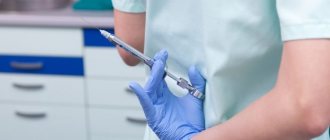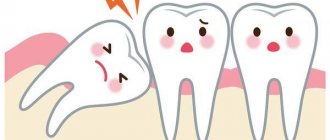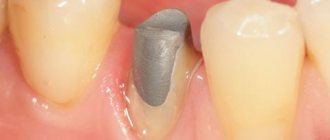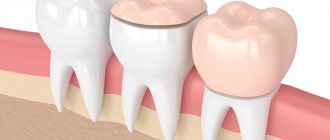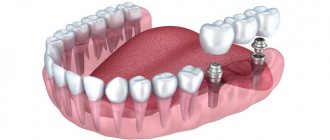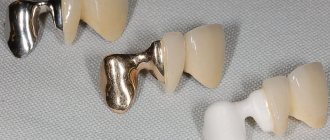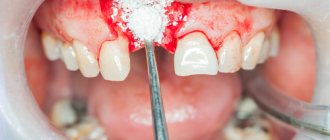After the patient’s body has received a stressful shock, tissue healing takes longer, and the risk of complications is much higher. Therefore, those who are terrified of surgical interventions, who ignore going to the doctor even if they have severe toothache, are offered modern alternative methods - treatment under general anesthesia or sedation.
Indications
- panic fear of dental treatment or surgical operations,
- low pain threshold,
- increased gag reflex,
- the need to install a large number of implants or the duration of surgery,
- inability to use local anesthesia,
- “special” patients, for example, with psychological or neurological problems.
Advantages
- painless installation of any number of implants,
- the ability to treat teeth and correct all anomalies of the dental system at one time,
- reducing the risk of developing postoperative complications,
- The implant surgeon focuses solely on the operation, without being distracted by the patient’s emotions.
Is general anesthesia safe for dental treatment?
Reviews about dental treatment under general anesthesia from medical professionals indicate that the use of medicinal sleep in dentistry is safe for the health of patients, the main thing is that certain requirements are met, and in addition, the dosage of the anesthetic drug is selected correctly.
The dosage of an anesthetic drug during dental treatment under anesthesia is selected taking into account the following factors:
- General health of the patient;
- The weight of the person who will undergo dental treatment under anesthesia;
- Duration of treatment measures.
A person who wants to undergo dental treatment under anesthesia must undergo a general medical examination of the body and take a number of different tests in order to reduce the risk of possible complications and negative health consequences.
GOOD TO KNOW: When treating teeth under general anesthesia, the doctor may administer an additional dose of drugs if necessary. In addition, although the procedure is generally considered safe for patients, it should not be used too often!
Indications and contraindications for dental treatment under general anesthesia
There are both indications and contraindications for dental treatment under general anesthesia. It will also be useful to know all the details about them before you decide to use such a dental service.
Indications for dental treatment under anesthesia include:
- Extreme fear of dental treatment. The patient's panicky state can interfere with high-quality and effective dental treatment;
- Abnormally low pain threshold;
- High gag reflex;
- The need for dental implantation during which the patient will have to implant more than 4 artificial roots - implants;
- Dental treatment under anesthesia is indicated for patients with an allergic reaction to local anesthetic drugs;
- If you need to treat multiple caries or pulpitis in one visit.
dental treatment under general anesthesia is mainly used patients. It is less commonly used in pediatric dentistry.
Dental treatment under general anesthesia also has contraindications:
- It is not applicable in patients with lung diseases, certain diseases of the respiratory system, or heart;
- Dental treatment is not carried out in case of malfunctions of the endocrine system, diabetes mellitus, kidney and liver pathologies;
- You will have to refuse dental treatment under anesthesia if your immune system is poor or if you have infectious diseases.
The temporary limitation for dental treatment under anesthesia is pregnancy.
Who is contraindicated for anesthesia?
Despite the many advantages of using anesthesia, there are a number of contraindications that make it impossible to use this method.
Some contraindications are temporary and allow, after time, to return to consideration of the issue of general anesthesia. Some of the reasons are a relative contraindication, so the decision to use anesthesia is made together with the patient, taking into account possible risks and complications. General anesthesia for dental prosthetics is contraindicated if:
- heart defects, arrhythmias;
- adrenal tumors;
- diabetes mellitus;
Relative contraindications that are temporary:
- post-stroke and post-infarction periods (up to six months);
- pneumonia;
- bronchial asthma during relapse;
- acute bronchitis;
- acute diseases of the blood, kidneys, liver;
- acute infectious diseases;
- alcohol and drug intoxication.
Prices
| Initial appointment and consultation | |
| Consultation with Candidate of Medical Sciences, Associate Professor | 500 rub. |
| Registration of a medical card | 100 rub. |
| Consultation with a doctor of medical sciences | 500 rub. |
| Initial doctor appointment with consultation | 300 rub. |
| Porcelain, metal-ceramic dentures | |
| Implant analogue | 0 rub. |
| Impression transfer | 0 rub. |
| Abutment | 0 rub. |
| Manufacturing of a crown from zirconium dioxide ZrO2 (vestibular reduced) (without the cost of zirconium) | 8500 rub. |
| Making a crown from zirconium dioxide ZrO2 full anatomy (without the cost of zirconium) | 7500 rub. |
| Custom abutment without zirconia cost (not including fixation screw and titanium base) | 5500 rub. |
| Manufacturing of ceramic crowns, veneers, inlays using the CEREC method | 21000 rub. |
| Metal-ceramic crown on an implant (without abutment cost) | 15,000 rub. |
| Manufacturing a metal-ceramic tooth crown with a ledge and a ceramic shoulder | 8500 rub. |
| Making a metal-ceramic tooth crown with a ledge | 7700 rub. |
| Composite tab | 5000 rub. |
| Making a crown based on zirconium dioxide on abutments | 12000 rub. |
| Ceramic inlay | 9000 rub. |
| Ceramic veneer | 13000 rub. |
| Metal-free composite crown | 5500 rub. |
| Collapsible model (1 jaw) | 800 rub. |
| Metal-ceramic crown on a gold alloy (without gold cost) | 14,000 rub. |
| Manufacturing of pressed ceramic crowns on a metal frame (up to 4 units) | 1100 rub. |
| Manufacturing without a metal ceramic crown | 1100 rub. |
| Correcting chipped metal-ceramic teeth | individual rub. |
| Solid crown without veneer | 5700 rub. |
| Making a metal-ceramic tooth crown | 7500 rub. |
| Fixed prostheses made of gold alloy | |
| Stump inlay with gold pin (three-root) | 5500 rub. |
| Stump inlay with gold pin (double-root) | 4200 rub. |
| Stump inlay with gold pin (single root) | 3500 rub. |
| Replacing, installing or moving 1 gold clasp | 1100 rub. |
| Soldering parts | 1500 rub. |
| Pin tooth with ring and plastic facet according to Richmond | 5000 rub. |
| Facet (with plastic lining) | 5000 rub. |
| Cast tooth (including for removable denture) | 5000 rub. |
| Cap crown with facet lined with plastic | 6600 rub. |
| Crown stamped for support-retaining clasp | 5000 rub. |
| Manufacturing of a stamped restoration crown | 5000 rub. |
| Clasp dentures made of carbon alloy | |
| Replacing a MK lock | 13000 rub. |
| Relining the clasp denture with micro-locks | 4200 rub. |
| Replacing one lock (Bredent company) | 4200 rub. |
| Manufacturing of attachment Ankersystem | 21000 rub. |
| Manufacturing of the Bredent attachment | 14,000 rub. |
| Production of cast beams (for clasp with micro-locks) | 7000 rub. |
| Manufacturing of attachment from MK company | 28,000 rub. |
| Making interlock (for clasp with micro-locks) | 7000 rub. |
| Making a fire-resistant model (for clasp with micro-locks) | 3500 rub. |
| Manufacturing of stamped steel counter rod | 800 rub. |
| Manufacturing a steel or HC alloy tiller rod with 2 solderings | 800 rub. |
| Making a restrictive edge for plastic in a metal saddle | 800 rub. |
| Making a branch of the connecting element | 1000 rub. |
| Making a claw-shaped process (splinting tarsus) | 700 rub. |
| Making a saddle (mesh) for fastening with plastic | 1100 rub. |
| Making an occlusion pad (foot) | 800 rub. |
| Manufacturing a multi-link clasp (1st link) | 800 rub. |
| Making a double clasp | 800 rub. |
| Making a Jackson clasp (ring-shaped) | 900 rub. |
| Making a Roach clasp (T-shaped) | 900 rub. |
| Manufacturing of support-retaining clasp | 900 rub. |
| Making a spring clasp | 800 rub. |
| Making a fireproof model | 1900 rub. |
| Manufacturing of a cast tooth with a plastic facet | 800 rub. |
| Making a cast tooth | 800 rub. |
| Making a cast base (instead of an arc) | 5000 rub. |
| Making an upper or lower arch (frame) | 5000 rub. |
| Removable plastic laminar dentures | |
| Repairing a molded plastic prosthesis | 4000 rub. |
| Making a bite template | 450 rub. |
| Repairing a prosthesis | 1100 rub. |
| Isolation of the bony prominence | 500 rub. |
| Making a clasp | 800 rub. |
| Relining a removable denture | 3500 rub. |
| Cold cooking | 5000 rub. |
| Mesh for reinforcing a removable denture | 3500 rub. |
| Making an individual spoon (hard) | 2200 rub. |
| Making a soft pad for the base | 2800 rub. |
| Replacement/installation of a plastic tooth in a prosthesis | 2200 rub. |
| Manufacturing of unilateral removable dentures from pressed plastic | 20,000 rub. |
| Manufacturing of one removable denture from pressed plastic | 39,000 rub. |
| Manufacturer of partial removable prosthesis | 11500 rub. |
| Making a complete removable denture | 19,000 rub. |
| Titanium nitride coating | |
| Crown, facet, cast | 700 rub. |
| Simple clasp | 600 rub. |
| Covering the clasp frame | 1400 rub. |
| Fixed dentures made of steel and cold alloy | |
| Final polishing (at customer's request) | 300 rub. |
| Single crowns and bridges of full anatomical shape of any length (without final polishing) | 1100 rub. |
| Soldering parts | 600 rub. |
| Stump inlay with steel pin (three-root) | 2700 rub. |
| Stump inlay with steel pin (double-root) | 2400 rub. |
| Stump inlay with steel pin (single-root) | 1800 rub. |
| Plastic crown with pin | 2200 rub. |
| Plastic crown | 2200 rub. |
| Foot in a bridge | 600 rub. |
| Steel facet | 2700 rub. |
| Cast steel tooth | 2400 rub. |
| The crown is stamped steel coated with titanium dioxide and plastic. Facing-cap | 3500 rub. |
| Stamped steel crown for support-retaining clasp | 2400 rub. |
| Manufacturing of stamped steel restorative crown | 2400 rub. |
| Zirconium dioxide ZrO2 | |
| Milling a shaft for a screw (for each unit) | 100 rub. |
| Additional payment for each unit on abutments/titanium base (support part) | 150 rub. |
| Complete production of dentures (full anatomy) DD Bio ZW iso, DD Bio ZX, DD cube X | 4000 rub. |
| Complete production of dentures (with reduction) DD Bio ZW iso, DD Bio ZX, DD cube X | 4500 rub. |
| Complete production of dentures (framework) DD Bio ZW iso, DD Bio ZX, DD cube X | 5000 rub. |
| Custom abutment (hybrid) of full anatomical shape on a titanium base (not including fixation screw and titanium base) | 2100 rub. |
| Custom abutment (hybrid) reduced anatomical shape on a titanium base (not including fixing screw and titanium base) | 1800 rub. |
| Surcharge for zirconium dioxide full anatomy and reduced | 2300 rub. |
| Final finishing, finishing painting and glazing (combined with codes 07.2;07.4) | 900 rub. |
| Additional pin for the collapsible stump tab | 700 rub. |
| Multi-root collapsible stump inlay of full anatomical shape (including one collapsible pin) | 2500 rub. |
| Multi-root collapsible core inlay with reduced anatomical shape (including one collapsible pin) | 2300 rub. |
| Single-root non-removable stump inlay of full anatomical shape | 2100 rub. |
| Single-root non-removable stump inlay of reduced anatomical shape | 1900 rub. |
| Making a crown from zirconium dioxide ZrO2 (vestibular reduced (“Zircodent”)) | 7500 rub. |
| Making a crown from zirconium dioxide ZrO2 full anatomy (“Zircodent”) | 6500 rub. |
| Fixed dentures made of silver-palladium alloy. Together with gold crowns | |
| Facet | 5500 rub. |
| Stump inlay with SP-alloy pin (three-root) | 4200 rub. |
| Stump inlay with SP-alloy pin (double-root) | 3500 rub. |
| Stump inlay with SP-alloy pin (single-root) | 3500 rub. |
| Soldering of parts, foot in a bridge prosthesis | 1500 rub. |
| Clasp crown, restorative, cast tooth | 5000 rub. |
| Cap crown, tooth according to Richmond | 5000 rub. |
| Other works | |
| Temporary crown made of PMMA | 2200 rub. |
| Modeling teeth from wax (1 unit) | 450 rub. |
| Template for implants | 7200 rub. |
| Unloading mouthguard | 2200 rub. |
| Abutment check (1 jaw) | 2800 rub. |
| Making a release tray (for whitening) | 1500 rub. |
| Making a sports mouth guard | 2000 rub. |
| Making a stump inlay from plastic (direct method) | 750 rub. |
| Cementing ceramic inlay | 2800 rub. |
| Cementation of ceramic veneer | 2800 rub. |
| Cementation of a ceramic crown (on a lightweight frame) | 2800 rub. |
| Cementation of a ceramic crown (without a metal frame) | 2800 rub. |
| Three-root tab (not direct method) | 7200 rub. |
| Double-root tab (not direct method) | 5500 rub. |
| Single-root tab (not direct method) | 5000 rub. |
| Temporary crown made of plastic (direct method) | 1500 rub. |
| Cementation with dual-curing composite cement | 2200 rub. |
| Splinting of mobile teeth with transparent fiberglass in the color of the tooth (per 1 tooth) | 2800 rub. |
| Cementing with temporary cement (imported) | 220 rub. |
| Retraction thread | 170 rub. |
| Disposable spoons | 250 rub. |
| Disposable instruments | 250 rub. |
| Manufacturing of diagnostic models | 700 rub. |
| Making a bite model from plaster | 400 rub. |
| Taking impressions with alginate masses: cromopane, upin, alginoplast | 500 rub. |
| Corrective impression for metal ceramics | 650 rub. |
| Basic impression for metal ceramics | 650 rub. |
| Removing an old metal-ceramic crown | 800 rub. |
| Removing an old crown made of steel, gold, plastic | 450 rub. |
| Crown cementation | 550 rub. |
| Correction of a removable denture not made in our clinic | 650 rub. |
| Anesthesiology | |
| Anesthesia for orthopedic preparation of teeth (per 1 tooth) | 2000 rub. |
| Anesthesia for surgical operations | 18,000 rub. |
| Anesthesia for uncomplicated tooth extraction | 6000 rub. |
| Using a perfuser and imported disposable system | 7000 rub. |
| Use of anesthesia and respiratory equipment | 2500 rub. |
| Laryngeal mask placement | 2500 rub. |
| Cardiac monitoring | 1500 rub. |
| Diprivan bottle | 3000 rub. |
| Diprivan | 1500 rub. |
| Premedication | 2500 rub. |
| Disposable system | 2500 rub. |
| General anesthesia for each tooth over 10 | 1500 rub. |
| General anesthesia (from 5 to 10 teeth) | 16,000 rub. |
| General anesthesia (from 1 to 5 teeth) | 8000 rub. |
Sign up for a free consultation
Advantages of using general anesthesia for dental treatment
What benefits can you get by using the service of dental treatment under anesthesia in Moscow? There are quite a lot of them:
- Dental treatment under anesthesia takes place without pain, without psychological discomfort and emotional stress;
- It becomes possible to carry out complex or lengthy dental treatment in the shortest possible time;
When treating teeth under anesthesia, the doctor fully concentrates on his work, is not distracted by the patient’s reactions, and this has a positive effect on the quality of the procedures performed.
The concentration and focus of a specialist are especially important when performing complex operations such as implantation, tooth extraction, and dental prosthetics.
USEFUL TO KNOW: Dental treatment under anesthesia also helps in endodontic treatment - treatment of tooth canals. This is a rather uncomfortable procedure for the patient, but it cannot be avoided if you need to cure pulpitis or periodontitis. Rushing to treat canals can result in the cavities being insufficiently cleaned or, even worse, a piece of dental instrument remaining in the canal. Such errors in the treatment of canals cause a relapse of the inflammatory process!
All these advantages of dental treatment under general anesthesia in their reviews not only by professional dentists, but also by patients who have already undergone the procedure.
How is the prosthetic procedure performed?
Types of prosthetics
There are two main types of dental prosthetics – removable and fixed. Fixed dentures are single crowns or bridges fixed to supporting elements (teeth, tooth roots or dental implants) that are worn for several years.
The most common type of fixed prosthetics is prosthetics using metal-ceramic structures. But there are more modern methods of prosthetics based on a material such as zirconium dioxide, which is hypoallergenic and completely biocompatible. The structure of the material allows you to achieve the most aesthetically attractive appearance of ceramic restoration. First of all, this is relevant for the teeth of the anterior group.
Veneers are also used in aesthetic prosthetics. These are fairly thin ceramic overlays that cover the front part of the tooth after fine grinding of the enamel.
Removable dentures are installed in the absence of teeth or the absence of a large number of them: they can be either complete or partial.
The most economical option is a plastic prosthesis: a plastic base that follows the contours of the mucous membrane, on which plastic teeth and clasps (hooks for fixation) are located. There are also flexible or nylon prostheses that have a sufficient number of contraindications.
If you focus on a higher degree of comfort, then the best option is dental prosthetics using clasp dentures - a thin metal structure in the shape of an arc made of a cobalt-chromium alloy. Plastic in such a prosthesis is present only in the area of missing teeth. Fastening can be carried out either using clasps or locks.
When a person has six or more natural teeth left, a competitive solution with implantation will be micro-locking prosthetics: the tooth is processed, a metal-ceramic crown with locks is put on it, and the mating part of the lock is placed on a removable clasp denture.
Are there risks of complications after dental treatment under anesthesia?
The mechanism of action on the body of anesthetic drugs that are used in general anesthesia has not yet been fully studied by science. Therefore, the risks of some side effects after dental treatment under anesthesia cannot be completely excluded. These risks persist even if the person is absolutely healthy and all examinations have not revealed any contraindications to dental treatment under anesthesia. These risks must be taken into account when choosing a clinic.
Dental treatment under anesthesia is not carried out free of charge, and dentistry that offers this service to patients must not only employ a qualified anesthesiologist and resuscitator, but also must have the appropriate equipment.
Resuscitation devices, devices for monitoring absolutely all human vital systems, medications necessary for emergency cases.
How does general anesthesia work?
How general anesthesia works
A carefully measured dose of individually selected anesthesia drugs allows you to put the patient into a state of sleep for up to twelve hours . Usually, the procedure requires much less time and it is not at all necessary to keep the person in a state of deep sleep. So, during preparation for treatment, sleep is quite superficial , but the treatment itself or tooth extraction will be carried out already at a time when sleep is deep.
Are there alternatives to dental treatment under general anesthesia?
Of course, modern dentistry is ready to offer patients alternatives to dental treatment under anesthesia. First of all, this is local anesthesia, secondly, dental treatment while sleeping, under sedation. Sedation is a light medicated sleep in which the patient does not feel pain, but is not unconscious, he can even respond to the dentist’s requests and carry them out.
Dental treatment under anesthesia is indicated mainly when the patient has a strong panic fear of dentists, when performing complex types of surgical interventions.
If you just have to cure caries, but you still can’t cope with your anxiety, tell your doctor about it. The specialist can premedicate you with a sedative, which will remove unnecessary anxiety before treatment. Which option to choose for truly painless dental treatment? This issue should also be discussed with your doctor.
Indications
- Increased patient anxiety is the reason that any visit to a dental clinic is a seriously stressful experience.
- Neurological pathologies associated with a nervous, overexcited state of a person, mental disinhibition and an acute, but poorly controlled reaction to pain and any irritants.
- A gag reflex that occurs in response to any manipulation in the oral cavity. This violation is rare. But, nevertheless, it becomes an almost insurmountable obstacle to the normal work of the dentist.
- Allergic reactions to local anesthetic substances. The compounds that doctors at our clinic use to put a person under general anesthesia are very different in chemical composition from drugs for local anesthesia. Therefore, the likelihood of combined individual intolerance is practically excluded.
- Large-scale dental procedures. These are mainly surgical interventions in which local anesthesia will not be effective.
Prices for dental treatment under general anesthesia in Moscow
The price for dental treatment under anesthesia in Moscow will depend on what type of drug will be used and what specific operation will be performed on the patient. If a drug administered intravenously is used in dental treatment under anesthesia, the cost of anesthesia can range from 10,000 rubles. Anesthesia using the mask method will cost more - from 15,000 rubles per hour of medicated sleep.
exact price of dental treatment under anesthesia during a consultation with a doctor at our dental clinic in Moscow - “Firadent”. We offer our patients the service of dental treatment under anesthesia - for this, our clinic has the necessary equipment and employs competent specialists - an anesthesiologist and resuscitator.
Dentistry "Firadent" - all conditions for safe, painless and high-quality dental treatment of any complexity!
More about the procedure
Dental treatment should not be postponed until later, it is dangerous. The human immune system is depleted precisely when the source of infection in the oral cavity (caries) is not treated for a long time. This is an ideal habitat for bacteria to live and develop; in the event of acute respiratory diseases, serious complications can develop, such as bronchitis, otitis media, sinusitis, and sometimes pneumonia (pneumonia). Oral health is closely related to the overall health of the entire body.
The list of dental procedures that can be performed in a dream is no different from the traditional one. Our doctors treat caries and periodontal diseases, remove the remains of decayed teeth and roots, install implants and perform prosthetics.
These procedures can almost always be performed under local anesthesia. However, general anesthesia during dental treatment helps, first of all, to create comfortable conditions for the patient himself. General anesthesia eliminates the risk of any complications, discomfort and guarantees peace of mind to the person. And the clinic’s dentists have the opportunity to carry out procedures with the highest quality possible. After all, if a patient is prone to emotional reactions and does not tolerate the mere sight of instruments, this greatly complicates the doctor’s work.
We provide dental treatment to patients with acute pain and emergency conditions in all departments of SM-Dentistry. Our dentists work daily - seven days a week.
Sedation or anesthesia
If you choose the lesser of two evils, then dental implantation under sedation is preferable to general anesthesia. But its use must be taken responsibly, weighing all the pros and cons.
The use of sedation is indicated for:
- severe dental phobia (up to panic attacks);
- highly developed gag reflex;
- mental or mental problems that make it difficult to follow instructions.
